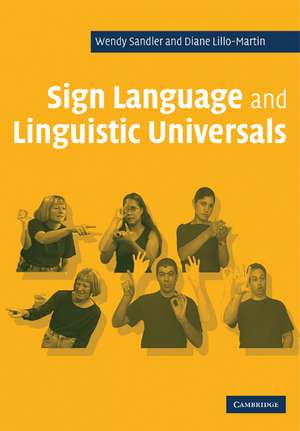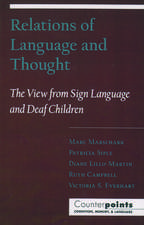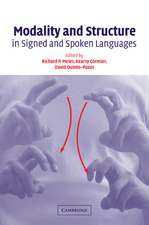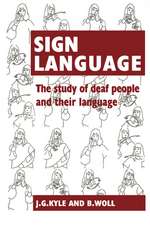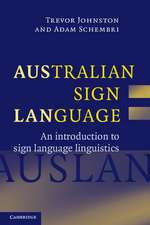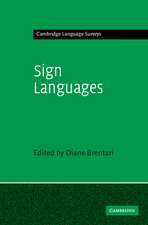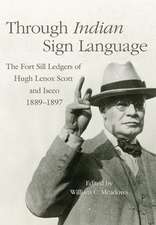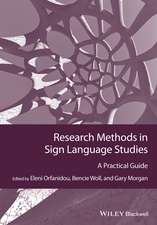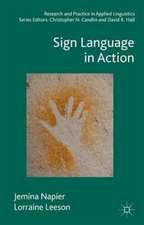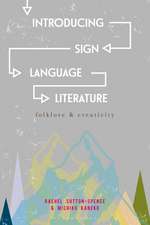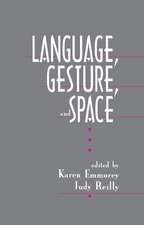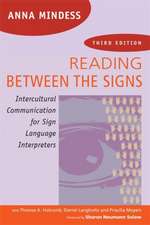Sign Language and Linguistic Universals
Autor Wendy Sandler, Diane Lillo-Martinen Limba Engleză Paperback – feb 2006
| Toate formatele și edițiile | Preț | Express |
|---|---|---|
| Paperback (1) | 535.67 lei 6-8 săpt. | |
| Cambridge University Press – feb 2006 | 535.67 lei 6-8 săpt. | |
| Hardback (1) | 983.16 lei 6-8 săpt. | |
| Cambridge University Press – feb 2006 | 983.16 lei 6-8 săpt. |
Preț: 535.67 lei
Preț vechi: 601.87 lei
-11% Nou
Puncte Express: 804
Preț estimativ în valută:
102.51€ • 106.63$ • 84.63£
102.51€ • 106.63$ • 84.63£
Carte tipărită la comandă
Livrare economică 14-28 aprilie
Preluare comenzi: 021 569.72.76
Specificații
ISBN-13: 9780521483957
ISBN-10: 0521483956
Pagini: 572
Ilustrații: 414 b/w illus.
Dimensiuni: 170 x 244 x 29 mm
Greutate: 0.91 kg
Editura: Cambridge University Press
Colecția Cambridge University Press
Locul publicării:Cambridge, United Kingdom
ISBN-10: 0521483956
Pagini: 572
Ilustrații: 414 b/w illus.
Dimensiuni: 170 x 244 x 29 mm
Greutate: 0.91 kg
Editura: Cambridge University Press
Colecția Cambridge University Press
Locul publicării:Cambridge, United Kingdom
Cuprins
Part I. Introduction: 1. One human language or two?; Part II. Morphology: 2. Morphology: introduction; 3. Inflectional morphology; 4. Derivational morphology; 5. Classifier constructions; 6. Entering the lexicon: lexicalization, back formation and cross-modal borrowing; 7. Morphology: conclusion; Part III. Phonology: 8. Meaningless linguistic elements and how they pattern; 9. Sequentiality and simultaneity in sign language phonology; 10. Hand configuration; 11. Location: feature content and segmental status; 12. The non-dominant hand in the sign language lexicon; 13. Movement; 14. Is there a syllable in sign language?; 15. Prosody; 16. Phonology: theoretical implications; Part IV. Syntax: 17. Syntax: introduction; 18. Clausal structure; 19. Clausal structure across sign languages; 20. Variations and extensions on basic sentence structures; 21. Pronouns; 22. Topic and focus; 23. WH-questions; 24. Syntax: summary and directions; Part V. Modality: 25. The effects of modality: linguistic universals and sign language universals.
Recenzii
'This book quite nicely fills a void long present in the sign linguistics literature. Most sign linguistics volumes have focused on one particular issue or theme … within just one sign language … the book is very reasonably priced, and you get quite a lot for your money … I recommend this book to linguists interested in learning more about sign languages. Given the overall theme, the book would be of particular interest to those studying language typology. I would also recommend this book to students who have some background in theoretical linguistics (particularly phonology and syntax), and to anyone who is interested in the nature of modality and human language.' Journal of Linguistics
Notă biografică
Descriere
This 2006 study compares sign languages with spoken languages, in order to seek their shared universal properties.
